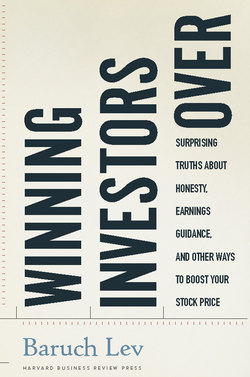Читать книгу Winning Investors Over - Baruch Lev - Страница 17
На сайте Литреса книга снята с продажи.
Chapter 2 Do We Have a Story for You How Soft Information Can Change Stock Prices
ОглавлениеIn This Chapter
How to overcome investors' “limited attention.”
What makes a conference call effective?
How the tone of managerial communications matters, not just the numbers.
How investor relations make a difference.
The Children's Place, a retailer of—what else?—children's apparel and accessories, opened the year 2003 with a quarter to forget: its EPS, at $.21, missed analysts' consensus estimate by $.04 and fell far short of the year-earlier EPS of $.56. If this was not enough, same-store sales, a key retailers' performance measure, fell 13 percent, and gross profit decreased to 38.6 percent of sales from 45.7 percent a year earlier. The May 15, 2003, conference call following this grim news opened with the CFO tersely pointing out several reasons for the financial results—a decrease in average transaction size, sales price decreases, increases in employee training and payroll costs, and severe winter weather. (Wouldn't you expect an increasing demand for children's clothes as the weather worsens?) The CFO went on to expand on the future: “Looking ahead, we remain confident that our business is moving in the right direction, as evidenced by our improved sales and transaction trends …” The CEO then joined the call and, abstracting from inconvenient details, had this to say on the quarter: “We are pleased with the progress we made in the first quarter … We made progress in our strategic initiatives and they remain on track yielding positive results in the following key performance indicators, as compared to last year.”
What followed was a litany of presumably positive indicators, such as increases in customer conversion rates and units per transaction. As for the large increase in inventory levels during the quarter—a frequent indicator of deteriorating business—the CEO said: “Inventory levels are now well positioned to support our business.” And, he concluded, “we are further streamlining our operations to leverage our infrastructure while at the same time supporting our growth. As we reflect on the challenges that we have been facing, we look forward to the many opportunities that lie ahead of us. Our early signs of progress encourage us and we remain confident about achieving our long-term objective of making the Children's Place the number-one brand in children's clothing. We believe we have the right formula and the right strategies to achieve this ambitious goal.”
All this optimism and progress notwithstanding, during the conference call, Children's Place executives adamantly refused to provide any quantitative earnings or expense guidelines for the next quarter. To an analyst's question about the main components of the deteriorating gross profit, an inquiry about past operations, not a request for prediction, the CFO replied: “John, on the gross profit breakdown, we don't specify the amounts, but we do list them in order.” All this, in reaction to an all-around disappointing quarter.1 No wonder that the cheerful, forward-looking message of Children's Place executives didn't do much to lift the spirits of investors: Children's stock price fell by over 5 percent during the call day and the following couple of days.2
While reading the transcripts of scores of conference calls I was occasionally reminded of the classic On Bullshit, by the renowned Princeton philosopher Harry Frankfurt who equates his book's theme to the more palatable term hot air, and explains: “When we characterize talk as hot air, we mean that what comes out of the speaker's mouth is only that. It is mere vapor. His speech is empty, without substance or content. His use of language, accordingly, does not contribute to the purpose it purports to serve. No more information is communicated than if the speaker had merely exhaled.”3 Frankfurt goes on to distinguish bullshit from a lie: “When an honest man speaks, he says only what he believes to be true; and for the liar, it is correspondingly indispensible that he considers his statements to be false. For the bullshitter, however, all these bets are off: he is neither on the side of the true nor on the side of the false. His eye is not on the facts at all, as the eyes of the honest man and of the liar are, except in so far as they may be pertinent to his interest in getting away with what he says.”4
Chapter 3 is devoted to truths and lies in financial reporting and their consequences. Here, I deal with a subtler dimension of communication with investors—soft information—and show, among other things, that bullshit often defeats the communicator's purpose, whereas relevant, credible information—details later—will improve investors' perceptions of the company, even in the wake of a disappointing quarter or year. Soft information, not just data, matters, as well as its tone and delivery. Above all, investors' seriously limited cognitive capacity, which economists often ignore, has to be carefully accommodated by the communicator or executive.
